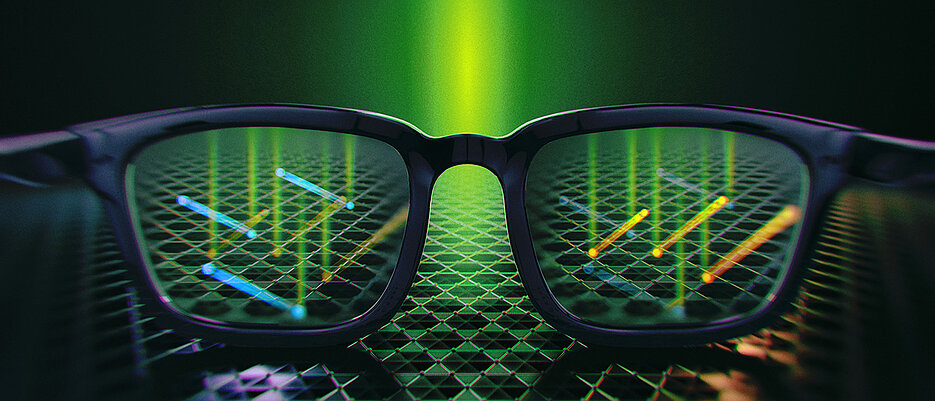An international team of scientists has succeeded in experimentally confirming a characteristic of topological materials. The Universities of Würzburg and the Dresden with their Cluster of Excellence ct.qmat were involved.

They are seen as a beacon of hope for energy-saving electronics and the high-tech of the future: topological quantum materials. One of their properties is the conduction of spin-polarized electrons on their surface – even though they are actually non-conductive inside. To put this into perspective: In spin-polarized electrons, the intrinsic angular momentum, i.e. the direction of rotation of the particles (spin), is not purely randomly aligned.
To distinguish topological materials from conventional ones, scientists used to study their surface currents. However, an electron’s topology is closely linked to its quantum mechanical wave properties and its spin. This relationship has now been demonstrated directly by means of the photoelectric effect – a phenomenon in which electrons are released from a material, such as metal, with the aid of light.
Visualizing the topology of electrons with “3D glasses”
Prof. Giorgio Sangiovanni, a founding member of ct.qmat in Würzburg and one of the theoretical physicists in the project, likened this discovery to using 3D glasses to visualize the topology of electrons. As he explains: “Electrons and photons can be described quantum mechanically as both waves and particles. Therefore, electrons have a spin that we can measure thanks to the photoelectric effect.”
To do this, the team used circularly polarized X-ray light – light particles possessing a torque. Sangiovanni elaborates: “When a photon meets an electron, the signal coming from the quantum material depends on whether the photon has a right- or a left-handed polarization. In other words, the orientation of the electron’s spin determines the relative strength of the signal between left- and right-polarized beams. Therefore, this experiment can be thought of like polarized glasses in a 3D cinema, where differently oriented beams of light are also used. Our ‘3D glasses’ make electrons’ topology visible.”
Headed by the Würzburg-Dresden Cluster of Excellence ct.qmat – Complexity and Topology in Quantum Matter – this ground-breaking experiment, along with its theoretical description, is the first successful attempt at characterizing quantum materials topologically. Sangiovanni points out the essential role of a particle accelerator in the experiment, stating: “We need the synchrotron particle accelerator to generate this special X-ray light and to create the ‘3D cinema’ effect.”
Quantum matter, particle accelerators and supercomputers
The journey to this monumental success spanned a period of three years for the researchers. Their starting point was the kagome metal TbV6Sn6, a quantum material. In this special class of materials, the atomic lattice has a mixture of triangular and honeycomb lattices in a structure reminiscent of a Japanese basket weave. Kagome metals play an important role in ct.qmat’s materials research.
“Before our experimental colleagues could start the synchrotron experiment, we needed to simulate the results to make sure we were on the right track. In the first step, we devised theoretical models and ran calculations on a supercomputer,” says Dr. Domenico di Sante, the project lead and a theoretical physicist, who is also an associate member of the Würzburg Collaborative Research Center (SFB) 1170 ToCoTronics. The findings from the measurements lined up perfectly with the theoretical predictions, enabling the team to visualize and confirm the topology of the kagome metals.
International research network
The research project involved scientists from Italy (Bologna, Milan, Trieste, Venice), the UK (St. Andrews), the USA (Boston, Santa Barbara), and Würzburg. The supercomputer used for the simulations is in Munich, and the synchrotron experiments were performed in Trieste. “These research findings perfectly illustrate the remarkable results theoretical and experimental physics can produce when working in tandem,” concludes Prof. Sangiovanni.
Publication
Flat band separation and robust spin Berry curvature in bilayer kagome metals. Domenico Di Sante, Chiara Bigi, Philipp Eck, Stefan Enzner, Armando Consiglio, Ganesh Pokharel, Pietro Carrara, Pasquale Orgiani, Vincent Polewczyk, Jun Fujii, Phil D.C. King, Ivana Vobornik, Giorgio Rossi, Ilija Zeljkovic, Stephen D. Wilson, Ronny Thomale, Giorgio Sangiovanni, Giancarlo Panaccione, and Federico Mazzola. Nature Physics (2023). DOI: 10.5281/zenodo.7787937. https://www.nature.com/articles/s41567-023-02053-z






